City of Warrnambool Rowing Club – 140 years on the Hopkins River
By Susan Finnigan
- Acknowledgements
- Foreword
- 1: Inception to shed
- 2: 1890 - World War One
- 3: War to War
- 4: Peace, Olympics, alcohol, tragedy, a new shed and a few wins
- 5: Centenary celebrated, State Champions off to the Nationals
- 6: Moving along the bank
- 7: Masters and schools row through the wilderness years
- 8: Rowing on
- Life Members
- Presidents and Vice-Presidents: 1870-2015
- Committee: 1870-2015
- Committee: Warrnambool Ladies Rowing Club, 1911-1937
Chapter Six: Moving along the bank.
The Club had been frustrated in its attempts to extend their Clubrooms. The kitchen and toilets were in serious need of renovation and the boat storage area was inadequate. The suggestion from Council was to have a multipurpose building, shared between clubs.231 At a Rowing Club meeting in 1987 Jim Carter suggested the possible amalgamation of three to four clubs to go ahead with building extensions and requested a subcommittee be formed to liaise with interested clubs. The subcommittee was Nancye Crosbie, Peter O’Grady, David O’Grady, Bernie Crimmin and Clive Wooster.232 A special meeting was held on January 27, with representatives from the Cycling, Triathlon and Twin River Canoe Club, to investigate the feasibility of building a combined sporting complex. In September 1987 The Hopkins River Sports Club (H.R.S.C.) was formed with the Rowing Club nominating Jim Carter, John Stonehouse and Peter O’Grady as representatives.233 Instead of building extensions, the plan was to demolish the existing Clubrooms and boatshed, lay a new slab and build a boat storage area with shared Clubrooms above. The project was quoted and plans were submitted to Council. In November the Club submitted $1,000 to the Hopkins River Sports Club. 234
On the water the Club was also supporting the local community. John Stonehouse raised over $1,000 for the local hospital by rowing a single scull 225 kilometres in 24 hours. John started rowing in 1974, was the holder of six State titles and won numerous pair events with David McDougall. During the evening of this epic row, riverside residents kept lights on to light the way and show support. Numerous Club members supported this Guinness Book of Records attempt.235 The event started at 12 noon on June 13 1987 with witnesses rostered hourly. Times were recorded for each nine mile lap.
Events on the water lead to a suggestion that the Ski Club police the number of boats out at one time from 8am to 12 noon. The Council was to apply for the maximum speed to be changed to 30kpm maximum and 25kpm for the rest of the areas, including the transit lane, but remain at 15kpm at Jubilee Park.236
Licensing hours changed to Monday to Friday 5pm to 9pm, Saturday 12 noon to midnight and Sunday 5pm to 8pm, with the permit in David O’Grady’s name.237 Bar prices increased to glass 75c, pot $1.10 and stubby $1.50. The Club was robbed (by removing the skylight in the men’s toilet) with approximately $40 taken from the vending machine.
Rowers were enjoying the sport and perhaps being a little distracted. The Club had its annual regatta in 1987. There was a report of undisciplined rowers at the Dimboola and Horsham Regattas and a decision made that only crews prepared to train ‘with a view to winning’ were to be entered at the Mildura Regatta. There was concern about so many regattas being scheduled at Carrum and the difficulty SW Clubs would have to attend. A meeting of country rowing clubs was attended by Peter O’Grady, David McDougall and Bernie Crimmin, in Ballarat. To increase the profile and liaison for regional clubs it was determined to reform the Country Rowing Association.238
A highlight of 1988 was when Andrew McNeil finished second to eventual three-time Olympian Jason Day, in the Victorian Championships in the Junior Single Scull. Andrew McNeil joined the CoWRC in November 1986 after seeing rowing on TV at the Commonwealth Games and was urged to try rowing by school friend and Club cox Stephen ‘Benny’ King. Andrew went on to row at the 1988 Nationals held at Nepean River and rowed in the Junior Single, the Junior Double Scull with Mario Laing of MUBC and also Schoolboy Sculls for St Joseph’s Christian Brothers College (‘CBC’). At the Nationals, Andrew made the semi-finals finishing top 12 in the country. Andrew also won the D.A. McDougall Cup for the Club in the 1987-88 season.
In 1989 Andrew represented Warrnambool and CBC again at the Nationals in Collie WA however the regatta was cancelled after the heats were held, due to a cyclone hitting the regatta midweek. Warrnambool was delighted, when living in Melbourne and joining the Mercantile Rowing Club, he went on to win the Victorian Men’s Senior C Pair Championship in 1991, Lightweight Under 23 Four in 1992 and the 1993 Under 23 pair with eventual three time Olympic Gold Medallist, Drew Ginn. This was Ginn’s first ever Pairs Championship victory.
The highlight of Andrew’s rowing career was winning the National Lightweight Eight Championship in 1993 at Lake Wivenhoe in Queensland. Competing in an Adelaide, Mercantile, MUBC and Corio Bay composite crew, the crew set a national record time of 5:43. Other highlights of his career included placing second in the Men’s Under 23 Pair and Four at the 1992 Nationals held at Carrum Vic. In 1998, while living in the United States, Andrew won the Gold Medal in Men’s A Masters Double Scull at the US Nationals competing for the Atlanta Rowing Club.
Following his retirement from competitive rowing at the 1999 Nationals, Andrew went on to coach school rowing at Sydney Grammar, Somerville House in Brisbane and at the Geelong College. The highlights of Andrew’s coaching career included representing the United States rowing team at the Junior World Championships at Plovdiv Bulgaria in 1999, coaching the Men’s Junior Coxless Four. He completed his active representation duties acting as a Victorian state team selector during the 2001-2002 season.
Andrew continues to be a regular visitor to Warrnambool and maintains his strong ties with the sport through numerous rowing club memberships. Andrew commented that he remains extremely grateful to the City of Warrnambool Rowing Club and to his coach David McDougall and the Crimmin and O’Grady families for giving him an introduction to rowing, a sport that has had such a positive and significant impact on his life and career. Andrew’s family are also longstanding Club supporters. McNeil’s Garage currently maintains the Club’s boat trailer and have previously provided the tow vehicle for regattas along with previous regatta support and sponsorship239
In 1988 Jim Carter was Club President. He was a businessman who had been a Club rower and coach. Jim was pivotal in raising funds and reinvigorating the Club in the mid 80’s. By 1988 the number of Club rowers was starting to wane, although the Club was still active socially and David McDougall called for all members eligible for veteran rowing to consider forming crews. Membership was family $35 (plus VRA affiliation), senior $30 ($47 VRA) junior $15 ($22 VRA). John Stonehouse won the Most Successful Oarsperson.240
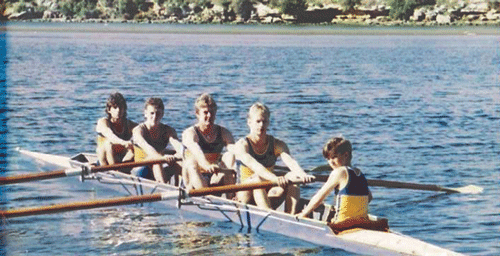
Warrnambool Novice Eight, Winners Victorian Country, Ballarat: 1987-88
S. King (bow), K. Wallace, P.B. Crimmin, M. Finnerty, G.M. Wallace, M.G. Bell, absent A.J. Slessar (stroke) & A.S. McNeil.
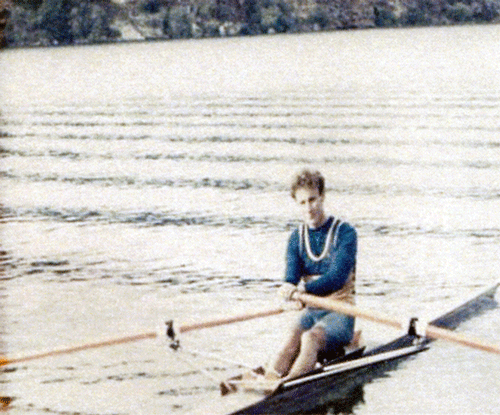
Andrew S. McNeil Novice Scull winner: 1986-87
Nagambie, Wentworth. 1988-89: Barwon, Dimboola/Horsham, Wendouree/Ballarat, Hamilton, Warrnambool, Colac.
The Club was trying, unsuccessfully, to sell debentures for the new building. The Hopkins River Sports Club requested the Clubrooms be open Friday nights with proceeds going to the new building fund. The members of the Warrnambool Cycling Club and Warrnambool Motorcycle Club were to be admitted as honorary members until such time as the H.R.S.C. ‘became operational or was dissolved’.241 Delegates to H.R.S.C. were John Stonehouse and reserve Paul Kavanagh. President Jim Carter reiterated the necessity to sell debentures.242
As mentioned, the 1989 the D.A. McDougall cup, for the oarsperson with the most finals wins, was awarded to Andrew McNeil, followed by Nanette Bell, Christine Wallace, Cathy Puxman and fifth Cathy Stonehouse.243 The Club had ‘one of our most successful’ seasons for quite a number of years. The Female Four had six wins with Nanette Bell, Christine Wallace, Cathy Puxman and Cathy Stonehouse, the Male Novice Eight had two wins and Andrew McNeil a stunning 11. Veteran crew David McDougall and Allan McKinnon won two races. The Club organised a ‘Hopkins Head of the River’ schools regatta. Warrnambool High School had over 50 competitors training from the Club’s boatshed, organised by John Shorthall.244
The Club had a new boat trailer and the boats were in ‘fairly good condition’. Bernie Crimmin was to be found at the Club most nights repairing boats and oars. John Stonehouse and David McDougall were coaches. Counter meals were sold monthly now on Saturday nights, ‘where else can you get a three course meal for $7’. The Club entreated members to buy a debenture or a named brick to raise funds for the new building.245
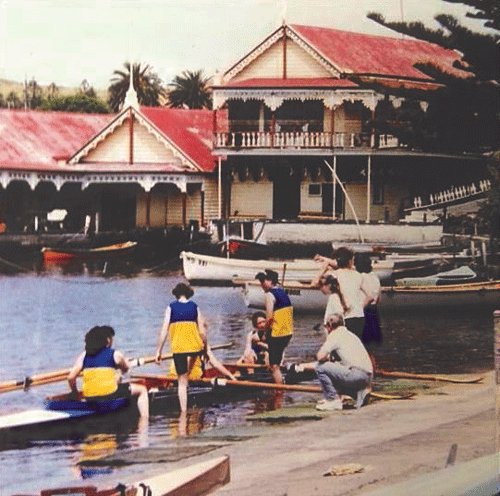
The ‘Social Club’ Four: 1989
Julia Lowey in bow, Rachel Hutchinson, Teresa Neoh stroke with Michelle Fitzgibbon coxswain. Jim Carter holding the boat.
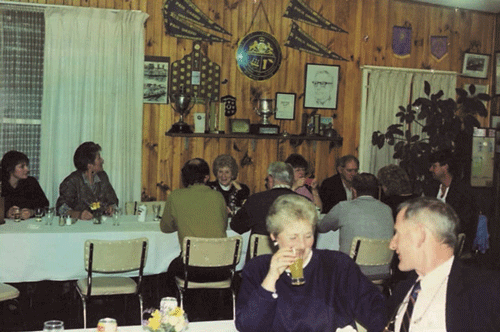
Rowing Club Dinner in the Clubrooms: July 1991
On the wall in the background is a framed sketch of Chas Dodds, drawn by Christine Birt in 1973. The rowing Club shield hanging on the wall was made by Max Baudinette using a plough disc.
A novel fundraiser and event rowers could participate in came to the Hopkins. International Whaleboat racing initially recorded in 1805 between America and Britain was revived on the Hopkins in 1989 as part of Wunta Festival. The Club had initiated whaleboat races in 1986 with the three services (Army, Navy and Air Force) competing prior to a Whaleboat Club forming and WUNTA being involved. The Australian 1991 crew included CoWRC and Surf Club rowers. Sweep and coach was John Stonehouse with fellow bricklayer Mark Smith, Stephen Rhook, Noel Read, Stephen Carter, Chris and Julian Melican.246 The Club continued to play a major role in organising and catering for this annual event until its demise. The Australian Whaleboat Championships returned to the river in 2009 and the Club continues to compete and help cater for the event.
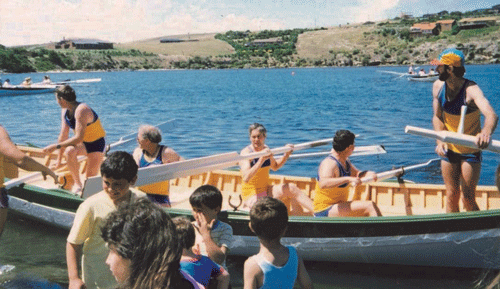
Warrnambool Rowing Club, Whale Boat crew: 1991
Max Baudinette, Bernie Crimmin, Clive Wooster, David O’Grady and sweep Colin McDonald.
The Warrnambool City Council was seeking $50,000 to help the Club upgrade its facilities.247 In 1990 H.R.S.C. reported that plans would soon be available and that debenture monies held by the Rowing Club were to be paid into the H.R.S.C. account. A key was given to the Motorcycle Club for the existing Clubrooms so they had access to hold their meetings.248249
Chas Dodds, stalwart of the Club died on March 2 1990. Chas spent much of his 84 years involved in the Club, starting in 1925. He was an active committee member, taking numerous positions, a rower and in his later years restored boats including the Club’s racing four, which had been used in the 1956 Olympic Games. He always kept a keen interest in the Club and is fondly remembered. A pencil drawing of Chas hangs in the Clubrooms with a perpetual shield named in his honour.
Most Successful Oarspersons in 1990 were Cathy Stonehouse and Nanette Bell.
It was now mostly secondary school students rowing although David McDougall was keeping a masters crew on the water. Peter Hayes, representing Brauer Secondary College and Nestles Rowing Club, presented a proposal for the format of the 1990-91 schools ‘Head of the River’ and the committee agreed with the Glenelg Games proposal.250 There was discussion regarding the ‘Hamilton Head of the Lake Regatta’ and the ‘Warrnambool Head of the Hopkins Regatta’ to be held in April 1991.251 Cathy Puxman was responsible for recruiting and helping with the coxing of students from the high school for the Head of the River. Other coaches were David McDougall, John Stonehouse and Paul Kavanagh with Bernie Crimmin doing the boat maintenance.252 The ‘young ones’ were again in trouble and a motion was passed in November 1990 that due to the poor performance of crews at the Hamilton Regatta crews ‘must train at least three times per week to be eligible to compete at regattas’.253 Interestingly the Club supported the Ski Club proposal to extend the ski run. In June 1991 the Rowing Club had success with a Masters crew of Paul Kavanagh, Allan McKinnon, David McDougall, John Stonehouse, with Wayne Gebert as cox, winning the Veteran Championships of Victoria, at Wentworth.254
Infrastructure improvements continued to be the dominant issue plaguing the CoWRC committee. The Warrnambool Surf Club proposed that they join with H.R.S.C. and build a house, with most of the materials donated, the clubs to supply the labour and profits to be split between the two clubs.255 Land was purchased at Gillin Park and the project started.
The Council had been frustrated in trying to attract funding for the historic Proudfoots Boathouse restoration along the bank from the CoWRC. Redevelopment of Proudfoots Boathouse was now linked with the H.R.S.C., to form a $1 million complex, to benefit the clubs and the restoration project. Rowing, cycling, motorcycling and others were to be the occupiers of a new complex. Jim Carter was President of the Sports Club.256
The Club had hosted its annual regatta however the Colac Regatta, usually held on the same weekend, was to be moved to Geelong. The option to continue on the same weekend as Colac, join with Hamilton or hold a two day regatta in Warrnambool with Nestles Rowing Club was mooted by Peter O’Grady. 257 258 Nestles Rowing Club had decided not to apply for a regatta so Warrnambool determined to contact Hamilton and Colac re their choice of regatta combinations. It was decided at the May meeting to apply for a standalone regatta on December 51992. Subsequently Hamilton applied to change their regatta to Sunday December 6 and a two day country regatta was again on the rowing calendar.
The Club had a successful rowing camp on the Glenelg River in January 1992. By March 1992 the Club had 30 people going to the Mildura Regatta. Not all were rowers, as the regatta is renowned for being ‘social’. Simone Burleigh and Ingrid Pearson were the successful crew winning the Women’s Novice Pair. A winter interclub regatta was proposed between CoWRC, Nestles, Hamilton and Brauer Rowing Club’s. Colac was interested in having a 10km time trial, in eights, on the Hopkins River. In October 1992 the Club had 25 crews entered in the Glenelg Games Regatta.
The Gillian Park house project was continuing with working bees and was up to plastering and painting.259 At an ordinary meeting of the H.R.S.C. in April 1992, the Motorcycle Club questioned the viability of its Club remaining as part of the H.R.S.C. They had invested $10.000 and were concerned there had been no benefit and they could have spent the money at their track building a canteen.260 H.R.C.S. fundraising included bingo at City Memorial Bowls Club. The house at Gillin Park sold in February 1993 for a profit of approximately $25,000. 261 A report on ‘Proudfoots Project’ included that all Club boats will be housed in one building and the gym will go into the Proudfoots building. 262
The fleet of boats was being replenished. The Club tendered $3,500 for the Fibreglass Regulation Four ‘Malagarra’, being offered by the Y.W.C.A.263 A $1,500 donation from Mrs Slesser helped pay for the boat and the boat was to be renamed the ‘W.A. Slesser’. The ‘Rennie’ was renamed the ‘Bob Stephenson’, as the original ‘Bob’ had been disposed of. Robin Murphy, the Club’s VRA delegate, organised a youth scull to be donated to the Club and the annual rowing camp was again held at the Nelson River.
In April 1993 the trophy winners were all women and it was obvious some of the perpetual trophies were inappropriately worded. Tactfully Most Successful ‘Oarsperson’ was Naomi Barratt. The D.A. McDougall Cup awarded for the most VRA wins was a tie between Naomi Barratt and Cristy Kelson. Best First Year was awarded to Jade Burleigh, Most Improved a tie between Rebecca Lyons and Jade Baillie, Most Dedicated Annie Bertram and Most Successful cox Emma Kelson. Best ‘Clubman’ was however Simone Burleigh, defiantly a Clubwoman or Club person.264 Bernie Crimmin coached a ladies crew to win the Female Novice Eight at a Geelong Regatta in November 1993. The crew was Naomi Barratt, Claire Durham Ashdown, Kasia Lynch, Simone Burleigh (Captain), Katrina Malseed, Jade Baillie, Rebecca Lyons, Cristy Kelson and cox Emma Kelson.265 Eight carbon fibre oars were also purchased and it was hoped they would bring ‘instant success’.
Rowers had their own meetings and reported to the general committee. Amalgamation with Nestles Rowing Club had been discussed between both club’s rowers. David McDougall, Paul Kavanagh and David O’Grady met with Nestles in July 1993. Thankfully for both clubs this did not eventuate as the Nestles Committee were not keen.266 Currently both clubs operate unique programs and the adage ‘boats bring boats’ is true, with Warrnambool big enough to support two clubs and both clubs fielding continuous membership enquiries.
The H.R.S.C. complex was under way and reports included that hydroponics and footings for the rowing shed had been poured. Nancye Crosbie asked if the Club should engage a solicitor to investigate any problems into the future with the boat storage section of the new Club complex and P. O’Grady was to discuss this with the H.R.S.C. solicitor. The H.R.S.C. building plans were drafted in 1993 and a project report included that the boatshed would now be widened by 3.8 metres at an extra cost of approximately $50,000. The Club was supplying labour for the painting, carpet laying, toilet and toilet partitions. 267 H.R.S.C. members were to install the boat racks in the new complex. Numerous articles appeared in the local paper claiming Proudfoots Boathouse needed urgent restoration. $100,000 funding was announced and a further $200,000 sought for the ‘on-again, off-again project’. The Council was considering borrowing $550,000 for the Hopkins River Sports Club to build their complex adjoining Proudfoots Boathouse268. By August 1994 the local paper headline was ‘Project Farce’- Blow-out in boathouse costs’.269 There were contract disputes, queries regarding the new H.R.S.C. building and concerns regarding potential flooding of the access and ground section. A reunion and farewell for the Clubroom was held in October 1993. Application was made to have the name ‘Proudfoots Tearooms’ registered. There was tension between many parties and with the best intentions it was apparent the outcome was not going to please everyone, in fact most people are still reticent to discuss this project. The Club was however committed and Paul Kavanagh was delegated to obtain information regarding the sale and removal of existing CoWRC Clubrooms.270
In planning for the annual regatta it was proposed that the Club purchase 40 new buoys. The Club sent four Hays blades to Adelaide for conversion to clever blades, at $140 per oar. Perhaps unsurprising in the 1990’s but now unheard of, Carlton United Brewery were the regatta sponsors.271
The young rowers were enjoying their rowing and giving the committee, mischievous boys themselves in the 70’s, some grief. In February 1994 poor behaviour was again an issue, ‘bad language’ had been used at regattas and around the Club and ‘if the reprimand is not heeded fines may apply’.272 The river was closed for the Head of Schools Regatta and the Club had wins at the Hamilton Head of the Lake Regatta.273 In April the annual regatta was discussed and it was determined to delete the school events, the date for the regatta was Saturday December 3 with Hamilton December 4. Most Successful Oarsperson was a tie between Naomi Barratt and Cristy Kelson. The D.A. McDougall Cup was a tie between Kasia Lynch and Katrina Malseed. Most Improved was Michelle Burleigh and Most Successful Coxswain Elissa Barratt.274 Callaghan Motors donated the use of a vehicle to tow boats to the Mildura Regatta. Female crews continued to dominate the Club in 1995 and rowers include Emma Kelson, Rachael Allen-Taylor, Michelle Burleigh, Jade Burleigh, and Elissa Barratt. It was however the men who supported the crews with David O’Grady continuing to coach. These girls entered the two fours in the Victorian Country Rowing Championships in March 1995, with a seat fee of $4. 275
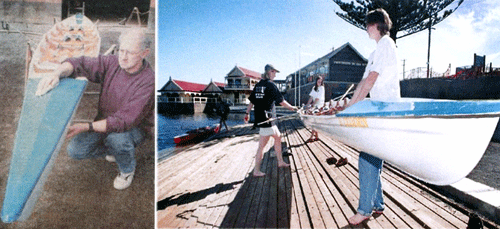
Photo 1: Bernie’s first and last boat. Photo 2: 1995, Rebecca Lyons (front), Simone Burleigh and Cristy Kelson (back) carry the new ‘B. Crimmin’
It took the retired plumber three years to make the fibreglass and Oregon boat, launched before the Club hosted a Glenelg Games competition on the Hopkins River in November 1995.
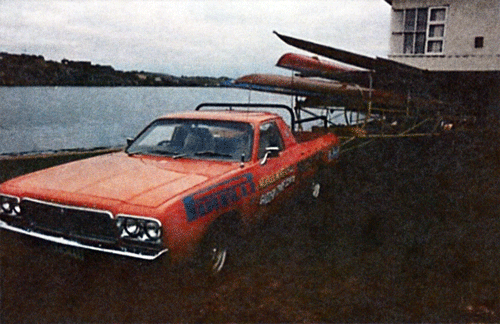
Callaghan’s and McNeil’s Garage provided the Club ‘tow’ vehicles for regattas.
In September 1994 Nancye Crosbie and Angela Karlinski published a history of the City of Warrnambool Rowing Club, written for the second ‘wake’ of the former Clubhouse, as they planned to move into new premises. This is an accurate work and a wonderful reference, a copy is in the rowing Clubrooms’ display cabinet.276
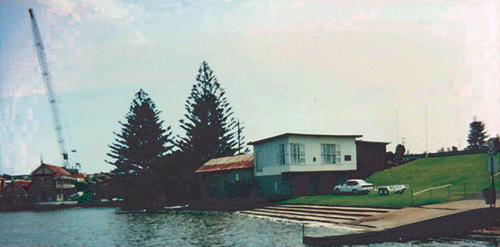
The 1990’s rowing shed
In the foreground (this was the ‘old’ ladies shed with a 1960’s extension including second storey Clubrooms, kitchen and toilets), the new H.R.S.C. complex is in the middle (obscured by the Norfolk Pines) and Proudfoots further along the bank, under renovation.
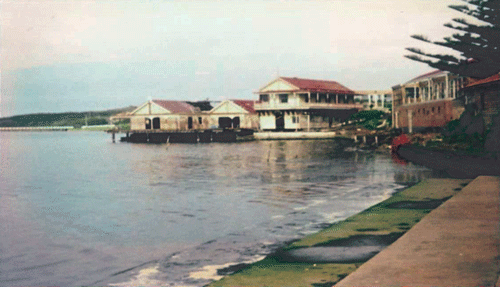
The new Hopkins River Sports Club (on the right) nearing completion
With an upstairs balcony (this was boxed in in later years) and Proudfoots Boathouse adjoining. The old cement landing, pictured in the foreground, is under the present timber one.
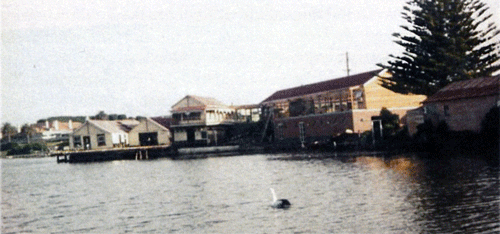
The new H.R.S.C between the old club and Proudfoots Boathouse.
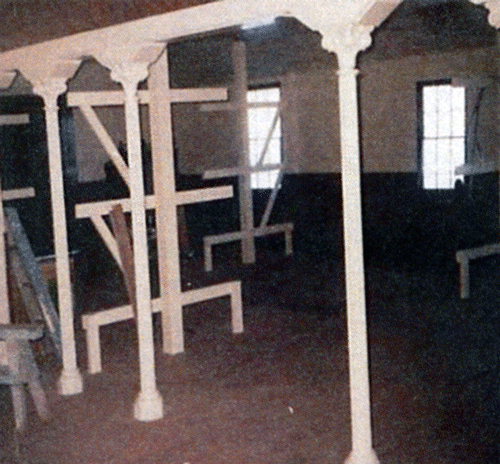
Boat racks in the Proudfoots restaurant area. These were never used.
The Rowing Club, which had been unable to find support to extend or replace its facilities in the 1970’s was now included in the Hopkins River Sports Club Inc. and was poised to be involved in a major complex. On 18 February 1996 the Warrnambool City Council Commissioners hosted the official opening of Proudfoots Boathouse and the Hopkins River Sports Club Building. The opening was performed by The Hon Robert MacLellan, M.L.A., Minister for Planning. Estimated project cost was $1.6m.277
Footnotes
231 Oral history, by Peter O’Grady with Susan Finnigan, 3rd December, 2015.
232 City of Warrnambool Rowing Club Minute Book 1984-1988. Ordinary Meeting, 13th January, 1987. Page 92.
233 City of Warrnambool Rowing Club Minute Book 1984-1988. Ordinary Meeting, 5th October, 1987. Page 120.
234 City of Warrnambool Rowing Club Minute Book 1984-1988. Ordinary Meeting, 2nd November, 1987. Pp 122-125.
235 ‘John row, row, row into record book’, Crowley, Rae. The Standard, 15th June 1987. Page 1.
236 City of Warrnambool Rowing Club Minute Book 1984-1988. Ordinary Meeting, 10th March, 1987. Page 100.
237 City of Warrnambool Rowing Club Minute Book 1984-1988. Ordinary Meeting, 12th May, 1987. Page 106.
238 City of Warrnambool Rowing Club Minute Book 1984-1988. Ordinary Meeting, 12th July, 1987. Page 109.
239 Details provided by Andrew Guerin and emails with Andrew McNeil. 13th January, 2016.
240 City of Warrnambool Rowing Club Minute Book 1989-1994. Executive Meeting, 12th May, 1991. Page 69.
241 City of Warrnambool Rowing Club Minute Book 1984-1988. Ordinary Meeting, 4th August, 1988. Page 138.
242City of Warrnambool Rowing Club Minute Book 1984-1988. Annual Meeting, 17th July, 1988. Page 140-41.
243 City of Warrnambool Rowing Club Minute Book 1989-1994. Executive Meeting, 7th May, 1989. Page 2.
244 ‘Rowing’s popularity gets a boost’, no author. The Standard, Tuesday August 29, 1989. Page 23.
245 City of Warrnambool Rowing Club Minute Book 1989-1994. Annual Meeting, 9th July, 1989. Attached reports page 7.
246 Wunta News Bulletin- CoWRC archives.
247 ‘City Council seeks recreation grants’, The Standard, 28th March, 1989. No page.
248 City of Warrnambool Rowing Club Minute Book 1989-1994. Ordinary Meeting, 26th February, 1990. Pp 26 & 30.
249 City of Warrnambool Rowing Club Minute Book 1989-1994. Ordinary Meeting, 30th April, 1990. Page 34.
250 City of Warrnambool Rowing Club Minute Book 1989-1994. 28th May 1990, 25th June, 1990. Pp 34 & 38.
251 City of Warrnambool Rowing Club Minute Book 1989-1994. Ordinary Meeting, 29th August, 1990. Page 46.
252 City of Warrnambool Rowing Club Minute Book 1989-1994. Annual Meeting, 15th July, 1990. Boat Captain Report, attached page 41.
253 City of Warrnambool Rowing Club Minute Book 1989-1994. Ordinary Meeting, 28th November, 1990. Page 55.
254 City of Warrnambool Rowing Club Minute Book 1989-1994. Annual Meeting, 21st July, 1991. pp 79-80.
255 City of Warrnambool Rowing Club Minute Book 1989-1994. Ordinary Meeting, 29th May, 1991. Page 72.
256 ‘$1m.River Club Plan’, no author. The Standard. 7th March, 1991. No page.
257 City of Warrnambool Rowing Club Minute Book 1989-1994. Ordinary Meeting, 29th January, 1992. pp 91-94.
258 City of Warrnambool Rowing Club Minute Book 1989-1994. Ordinary Meeting, 26th February, 1992. Page 96.
259 City of Warrnambool Rowing Club Minute Book 1989-1994. Ordinary Meeting, 25th March, 1992. pp 98, 100, 106.
260 ‘Hopkins River Sports Club’ minutes of General Meeting, 8th April 1992- attached to CoWRC minute book 1989-1994. Page 108.
261 City of Warrnambool Rowing Club Minute Book 1989-1994. Annual Meeting, 9th August, 1992. pp 107,108, 112, 127.
262 City of Warrnambool Rowing Club Minute Book 1989-1994. Ordinary Meeting, 25th October, 1992. pp 114, 118-19, 122, 124.
263 City of Warrnambool Rowing Club Minute Book 1989-1994. Ordinary Meeting, 25th October, 1992. Page 114, 118-19, 122, 124.
264 City of Warrnambool Rowing Club Minute Book 1989-1994. Special Meeting, 26th April, 1993. Page 132.
265 ‘Young Rowers shine at regatta’, no author. The Standard. 2nd November, 1993. Page 21.
266 City of Warrnambool Rowing Club Minute Book 1989-1994. Ordinary Meetings, May & June, 1993. pp 134-136, 140.
267 City of Warrnambool Rowing Club Minute Book 1989-1994. Ordinary Meeting, 22nd August, 1993. pp. 144-145,150.
268 ‘Proudfoots funding boost’, no author. The Standard, 21st April, 1994. Page 5.
269 ‘Project Farce’, Bayne R. The Standard. 3rd August, 1994. pp 1-2.
270 City of Warrnambool Rowing Club Minute Book 1989-1994. Ordinary Meeting, 27th September, 1993. pp 148.
271 City of Warrnambool Rowing Club Minute Book 1989-1994. Ordinary Meeting, 25th October, 1993. pp. 149-150.
272 City of Warrnambool Rowing Club Minute Book 1989-1994. Ordinary Meeting, 28th February, 1994. Page 157.
273 City of Warrnambool Rowing Club Minute Book 1989-1994. Ordinary Meeting, 28th March, 1994. Page 159.
274 City of Warrnambool Rowing Club Minute Book 1989-1994. Ordinary Meeting, 23rd May, 1994. Page 162-164.
275 Victorian Rowing Association Regatta entry form: Country Championship 12th March, 1995.
276 ‘The City of Warrnambool Rowing Club’, Crosbie, N., 24th September 1994. (Booklet). No page.
277 ‘Proudfoots $1.6m pride’, no author. The Standard, 18th February, 1996. No page.

